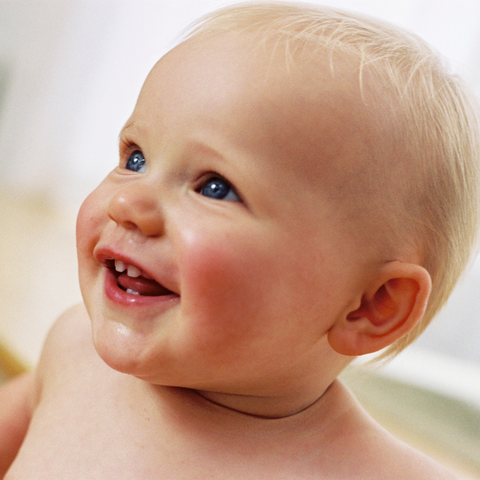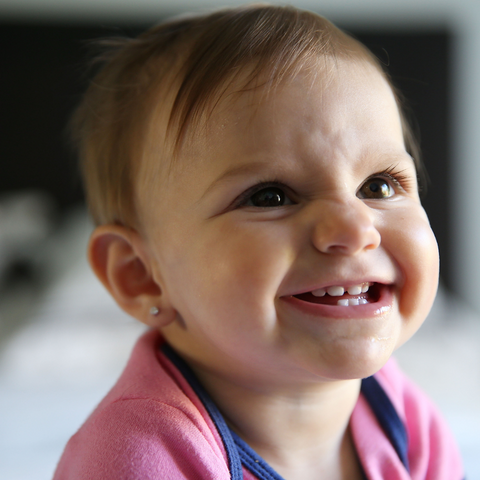Leaving a coin for the tooth fairy is one of the most classic parts of parenting, but first you have to wait for your little ones milk teeth to come through! This can sometimes be a difficult process, both for parent and child, so we’re here today to talk about teething, and how you can understand what’s happening in your baby’s mouth.

So when can I expect my baby’s first teeth?
Well, this a broad question. Some babies are actually born with their first teeth, while others start teething before they are 4 months old.
Most babies start teething at around 6 months, but some can start as late as 12 months! So the answer is normally anytime within their first year you can expect them to start teething.
What will happen when the teeth start coming through?
Well, sometimes a baby teeth emerge with little to no pain or discomfort at all, but often the process can be accompanied with some discomfort for your little one. There are some sign you can look at to tell if your baby is teething:
Your baby's gum is sore and red where the tooth is coming through:
One cheek is flushed
They are rubbing their ears
Your baby is dribbling more than usual
They are gnawing and chewing on things a lot
They are more fretful and upset than usual
What order will my baby’s teeth appear in?
Bottom incisors (bottom front teeth) – 5 to 7 months
Top incisors (top front teeth) – 6 to 8 months
Top lateral incisors (either side of the top front teeth) – 9 to 11 months
Bottom lateral incisors (either side of the bottom front teeth) – 10 to 12 months
First molars (back teeth) – 12 to 16 months
Canines (towards the back of the mouth) – 16 to 20 months
Second molars – 20 to 30 months
By the age of two and half years old you can expect your little one to have all of their milk teeth.
My baby is upset, how can I help?
It is true that Teething can be discomforting for some babies, but there are ways you can help to sooth them and make it easier. Remember though that every baby is different, so you may have to try a few things and solutions until you find something that works for you and your baby.

Chewing, chewing on and on!
One of the easiest and most visible signs of teething is that your baby will start gumming and chewing on objects, often fingers and toys. This is natural, but is important to make sure they don’t chew on anything that might harm them.
A teething ring can be a good and safe way of providing them with an object designed for this behaviour. Some teething rings can even be cooled first in the fridge, which also may help to ease you baby’s gums. Don’t put a teething ring in the freezer though, as it could become too cold and even potentially damage your baby's gums if it gets frozen. Also, don’t be tempted to tie the teething ring around your baby's neck, as this could become a choking hazard.
Once your baby is older than 6 months, you can give them other things to chew on, such as washed and raw fruits and vegetables. Remember to only do this is you are close to your baby though, in case they choke. Also try to avoid any foods that contain sugar, such as lollipops or sweets, because this can lead to tooth decay and gum disease (even if they don’t have all that many teeth yet!).
Teething gels
Teething gels are created to try and ease the symptoms of teething, but there is a lack of evidence on how effective they are. It is always a better option to try non-medicinal options for teething first, but if you do decide to use teething gels, make sure it is designed for babies and young children. It is also highly recommended that you first consult your pharmacist or paediatrician before using a teething gel, or a homeopathic teething gel, especially with the later.
Pain killers for teething
If your baby is still in pain, you may want to try giving them some medicine. If this is the case, then paracetamol or ibuprofen can be given to relieve teething symptoms in babies and young children aged 3 months or older, but remember that children under 16 years old should not have aspirin. Again, it is always recommended that you check the packaging of the medicine carefully to understand dosages and the correct amount to use. Always remember, if you're not sure about something, speak to your GP or pharmacist.
Other Hints and Tricks:
- Comforting or playing with your baby can distract them from any pain in their gums.
- Gently rubbing their gums with a clean finger may also help.
- If teething is making your baby dribble more than usual, gently wiping their face may help prevent a rash.
- You'll need to register your baby with a dentist when their teeth start coming through.
- Start gently brushing your baby's teeth with child appropriate toothpaste as soon as their first milk tooth breaks through.
We hope you found this guide to teething helpful! Let us know by following us on social media, where you can stay aware of other helpful guides and blogs!












